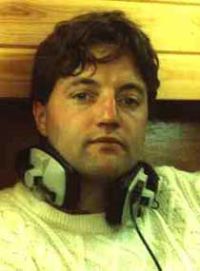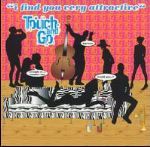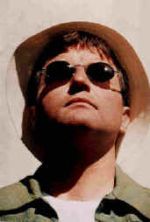
SR: Dear David, could you please describe the project you’re working under nowadays?
DL: I have been busy with film and soundtrack work for television as always, but I am doing less now so I can concentrate on a new pop project with a really amazing singer from London – It will be like Touch and Go – but a new direction. Different again was a big live event I did last summer at the Eden project in Cornwall UK, as part of the WOMAD festival there.
It was a multi layered, spectacular of music poetry and sound, played out in the immense tropical rainforest “biodome” building that the Eden Project is famous for. The idea was that you experienced different parts of the sound and music coming at you through the plants and trees, as you walked through the rainforest environment.
SR: That would be thrilling and amazing to hear it right from the its creator – how was “Touch and Go” project made?
DL: The Touch and go project started with “Would You..?” We had the idea of doing a latin dance project, which would be mainly instrumental, with a just a few well chosen vocals. I’m always striving to come up with tracks that have a concept or idea within them, which are not just a good tune and good lyric. Ideas that are as clever as i can make them, and slightly quirky, with a sense of humour. The concept of “Would You..?” was that you could play it, or give it to someone you fancied, and if you were shy, everything you wanted to say to that person would have been said for you already by the music!
The huge success of “Would You..? took me by surprise, we didn’t have the album to back it up. I focused on writing more tracks and putting an album together, still striving to make it as original and good as possible, and not just a load of tracks done quickly to capitalize on the success of “Would You..?”
 |
| "Touch & Go", album cover |
The concept for the album evolved as I worked on it, the idea was that it should be like the words and small bits of conversation you hear at a party, We called the style of music “Jazz Pop” Normally in jazz, the tradition is for players to improvise and make up their own ideas over a series of structured chords. To get the sound of the lead instruments as they are, I used jazz musicians and got them to improvise ideas over some chord sequences and beats. I then chopped their recordings into tiny sound bite segments (like the vocals), which I then re-played on my keyboard – making up new melodies and hooks.
SR: Touch and Go have been on tour in Russia last year. And we wonder are there just one and strict number of musicians or there’re people who replace the main collective?
DL: Jim Lynch played the trumpet on “Would You…?” and several tracks on the CD, so it’s great for him to be able to go out and be Touch and Go Live. Likewise, Vanessa is a fantastic vocalist, and is on several tracks as well. The two of them go out and do all of Touch and Go’s live appearances.
SR: Are there any planes to create Touch and Go -2?
DL: As I said, I’m working on a new project currently, which will sort of be like T+G but different.
SR: How about your own project named Dreamcatcher? Do you perform with them or it’s already buried in the past?
DL: I did the event at the Eden project last summer as Dreamcatcher, and with the new tracks I wrote, were two or three Dreamcatcher tracks. Before that I performed Dreamcatcher at WOMAD in Singapore a couple of years ago. I will be running the Eden tracks this July, as a warm up to the WOMAD festival in Reading UK. I’ve done a couple of remixes too, which have found their way on to the brilliant French chill out “Buddah Bar” compilations.
SR: By our sources Dreamcatcher wasn’t super popular, but most of the tracks our of its album have influenced many artists all around the world. Why didn’t you continue to work on this project further?
DL: I always like doing something different and trying new directions.
SR: What kind of mythology was placed as the basis for Dreamcatcher creation?
DL: I sort of made up my own mythology – I had this idea of a fantastically beautiful and mysterious otherworld paradise, which you could go to, and journey through by listening to the music. It wasn’t based anywhere in our world, but you would feel at peace and very much at home there. After the album was finished, Howard Moses, the video and CD cover designer, came up with the Chinese tangram concept, – Dreamcatcher as a huge and strange puzzle that the listener had to solve, that could be any shape or idea the listener wanted to feel. That was also a very appealing idea.
SR: There’s a theory that world music genre is not interesting to modern public nowadays. Do you agree with this?
DL: Generally, “World” music doesn’t seem to appeal to a mass audience, its all down to taste in the end. People tend to stick with what they know and like and what they are familiar with. Radio TV and record companies generally play safe and go with what people like. There are some fantastic world musicians out there that people would enjoy if they had more time to look listen and explore, but changing peoples tastes, and bringing in new sounds is a slow and lengthy process.
SR: Please tell is about the way you work and create in 2005. Do you use samples or there are any other secrets?
DL: I still work as i have always done, using a mixture of live musicians and vocalists, whose recordings I stretch, squeeze, bend, cut, paste and generally manipulate later, and a selection of sampled instruments and sounds. I tend to work more on the laptop these days, which is great – on the train, in Starbucks – on the kitchen table! I love the informality of people around, and of not being in a studio environment all the time.
 |
SR: Is your home recording studio large? Please describe it to us, that is interesting to know about the conditions where music magic happens.
DL: The laptop is definitely taking over – the technology is amazing and very liberating. But I often still work in my studio at home on top of the Malvern hills in the heart of England. Its very peaceful and chilled to be at home with my family, and I have a fantastic view out of my studio window, looking out towards Wales and the mountains beyond.I also work a couple of days a week in my apartment and studio in Central London, very close to Oxford Circus. I love being there for the buzz of London, in the centre of everything going on. Both studios are set up the same, quite simply with everything done on the computer, but with some very high quality michropones for recording. If you listen carefully, you’ll probably hear the london street noise in the background on my next album project!
SR: Tell us about your music favorites? What is in your player today? Are the any Russian composers you respect and love?
DL: I love Mussourgsky – I used to listen to an electronic interpretation of his music by a Japanese artist – Isao Tomita, who influenced me a lot in my late teens. I love fantastic anthemic music and songs – like Coldplay, and Keane – they may not be incredibly challenging to listen to, but they reach out and touch the hearts of so many people around the world, something I would love to do as well at them.
SR: The melody turns to be much more attractive the more it’s irregular and interrupted. The roots of jazz and swing are turning to be much more interesting today. Do you think it’s just a short phase or it will last for a long time?
DL: I love Swing, It would be great to bring it back into the mainstream as a rythmn, it’s so cool. I like Jazz too, and blues, it is incredible how many song melodies are made from the simple blues scale, “Would You” included. Everything comes around again. Music is so basic to us all, it is no wonder the rythmns and roots appear again and again – I hope Jazz and swing stay around – if they go, they will soon be back!
SR: What do you think about authenticity of modern music?
DL: The best music is the music that moves you in some way, reaches a part of you within. Its a totally personal thing, It may not have that effect on others who hear it. – there is some modern music that does that, and some that doesn’t – its always been the same, and I guess will continue to be.
SR: By your own opinion what will be popular and fashionable in music of tomorrow?
DL: Me!!!!
SR: When is the Big Style coming back to music?
DL: Give me about six months!
SR: Every piece of your music seem to be so much optimistic. Are you like that in your everyday life?
DL: I try to be – although i do have a sad and melancholy side to me too. I think its my celtic side coming through. I try and keep that under wraps – I don’t want to depress anyone…
SR: What would you like to wish to those who’s eager to become musicians?
DL: Keep going – do your absolute best, go as far as you can then take it even further – have a fantastic time, and enjoy it, cos its better than sex (almost!).
May 2005
—————–
Links:
Official site: http://www.davidlowemusic.com
Leave a Reply